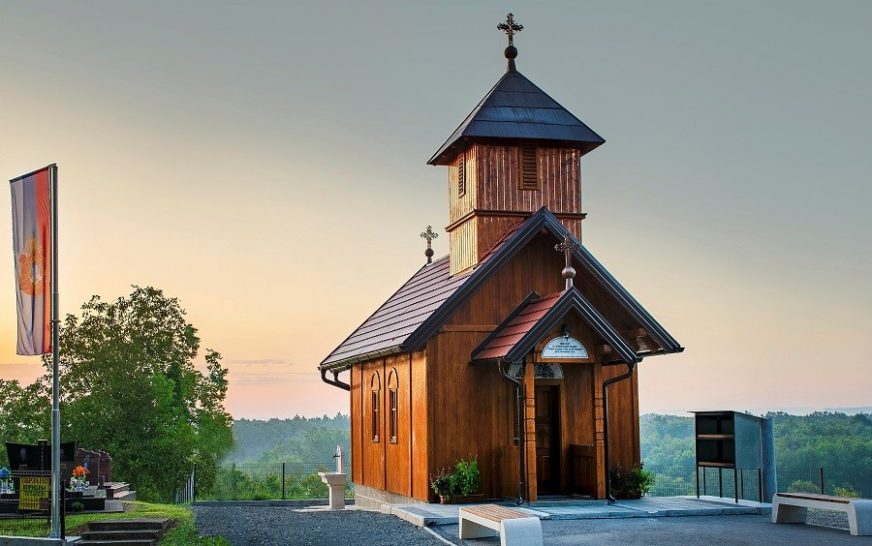Wooden church in Mašići
Text author: Micro Mreža
The wooden church built by resident Stevo Stojnić in the hamlet of Gaj near Gradiška, with the help of friends and neighbors, represents an important spiritual building in the whole of Potkozarje.
– I fantasized about this type of church even in my childhood days. That idea strengthened even more in me after the death of my father Dušan, who was buried in the cemetery next to the church. For more than half a century, I was spiritually nourished and strengthened by this idea, spiritually nourished by the desire to build a church. When my family had the financial conditions, three years ago, with the help of good people, my friends, and the support of my family, I started to realize my plan – Stevo confided in us, who, together with his wife Nada, was declared the godfather of the church by Bishop Jefrem.
The places of worship made of wooden logs in Potkozarje, the most famous one, which is in
Romanovci, where the writer Petar Kočić lived, has a long tradition and represents a landmark that testifies to the history of the Serbian people, their desire to preserve their faith in the most difficult times.
– Log cabin churches are monuments and witnesses of the difficult and disenfranchised life of our people throughout their long history. In those times, the Serbs showed determination to preserve their national identity at all costs, showing that no sacrifice is too great to bear for their salvation.
This encouraged me to build a wooden church from a very stable and long-lived cherub oak – Stevo Stojnić explained the reasons why he decided to use wood instead of brick or stone for the construction of the church.
Under its six-meter-high, eight-meter-long and four-meter-wide vault, about a hundred worshipers can be accommodated. The interior is dominated by the iconostasis made by Borislav Ćulum, and the church was designed by Nikola Pavlović. Stojnići are very grateful to them.
– Together with friends who accepted my idea with a lot of love and understanding, for three years we were attracted to this by a common thought. We have been eagerly waiting for the day when the log cabin will be completed, consecrated, for the people to be able to pray in it, to take care of it as a result of our joint effort, our primordial desire – said Stojnić, who is now planning the construction of a canopy and other facilities that will make this a place next to the canopy of old oaks, popularly known as the hamlet of Gaj, from where the view stretches far into the Lijevče plain, to get a new spiritual feature.
Bishop Petar Jovanović praised the construction of the church and the renunciation of the inhabitants of Gaj, Mašići, and neighboring villages in favor of this unique place of worship. Abou Stevo Stojnić and his family, he said that they are true and great benefactors to whom society and national interest are as important as their interest.
– The wooden church strengthens us spiritually, strengthens our faith, and customs, preserves the past, and traces the future of new generations – said Bishop Jovanović.
With the construction of the church, a revival of this area began. This was pointed out by Zoran Adžić, the mayor of Gradiska, saying that until recently the hamlet of Gaj was almost forgotten, but with the great will and effort of the locals, among whom Stevo Stojnić is the leader, living conditions have significantly improved. Several social facilities were built, and the most important is the road that was built to the facilities.
– We asphalted the road from Donja Jurkovica to Berek through this village and Dušanovo – Turjak and Nova Topola – Kozarska Dubica roads, which are also very important for this region – emphasized by mayor Adžić, emphasizing the initiatives of the inhabitants of the villages of Potkozarje as an important factor in creating better conditions for life and long-term development perspectives. Charity Stevo Stojnić emphasizes that the help of many during the construction of the church is very important.
Boško Turjačanin donated a thousand square meters of land for the church plot. The list of donors includes the city administration of Gradiška, “Niskogradnja” Laktaši, Danilo and Mirko Keserović, Ljubomir Vidović, Slavko Gajić, Boško and Žarko Turjačanin, Stojan Buvač, Zoran Kolundžija, Boško Kasagić, Rajko Raković, Momčilo Majdanac, Marjan Agatić, Milan Škorić, Gligo Kalajdžić, Tomislav, Milorad and Marko Stojnić.


